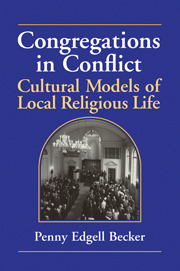Book contents
- Frontmatter
- Contents
- Tables
- Acknowledgments
- 1 “Who We Are” and “How We Do Things Here”: Local Understandings of Mission and Identity
- 2 The Congregations of Oak Park, River Forest, and Forest Park
- 3 Houses of Worship
- 4 Family Congregations
- 5 Community Congregations
- 6 Leader Congregations
- 7 Mixed Congregations
- 8 An Institutional Approach to Local Culture
- 9 American Congregational Religion
- Appendix A Data and Methods
- Appendix B The Interview Questions
- References
- Index
9 - American Congregational Religion
Published online by Cambridge University Press: 07 August 2009
- Frontmatter
- Contents
- Tables
- Acknowledgments
- 1 “Who We Are” and “How We Do Things Here”: Local Understandings of Mission and Identity
- 2 The Congregations of Oak Park, River Forest, and Forest Park
- 3 Houses of Worship
- 4 Family Congregations
- 5 Community Congregations
- 6 Leader Congregations
- 7 Mixed Congregations
- 8 An Institutional Approach to Local Culture
- 9 American Congregational Religion
- Appendix A Data and Methods
- Appendix B The Interview Questions
- References
- Index
Summary
Oak Park, River Forest, Forest Park
The understanding of American religion that motivates this study is that of an institutional field. A field is comprised of organizations with similar services or products (DiMaggio and Powell 1991:64). Eiesland (1998) shows that applying this concept to religious organizations within a specific locality is analytically useful in her study of how congregations reacted to social change in an exurban community outside of Atlanta. I am arguing that it is useful to apply this concept more broadly, to encompass American religion as an organizational field. This is different than thinking of American religion as a set of faith traditions or as a market that aggregates believing individuals who have religious preferences into some structured relationship with a set of religious providers. It is useful to think of American religion as an institutional field because this draws attention to particular features of the American religious landscape that need more attention and a more refined understanding.
Highlighting the relative autonomy of levels of organization, the idea of a field helps us to examine the ways in which denominations do and do not influence local congregational belief and practice. Focusing on the pragmatic practices and ways of doing things that form much of organizational and small-group culture, it allows us to examine when and in what ways the content of beliefs (a liberal or a conservative view on gender roles, for example) influences group process and when group process is shaped more by practices and ways of doing things that are compatible with a range of explicitly articulated beliefs.
- Type
- Chapter
- Information
- Congregations in ConflictCultural Models of Local Religious Life, pp. 206 - 236Publisher: Cambridge University PressPrint publication year: 1999



